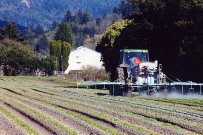This report to the City of Arcata describes a garden project organized by parents and Siskiyou Land Conservancy for Jacoby Creek Elementary School, in Arcata. The school leases city-owned land for the garden.
Although SLC President Greg King issued this report last month, it is worth noting now that most of the “next steps” (at bottom) are either accomplished or in process, with the exception of brassicas. Next year we’ll get those in for sure.
Report to the City of Arcata
Open Space and Agriculture Committee
Jacoby Creek Elementary School Garden Project
Presented by Siskiyou Land Conservancy
September 14, 2009

Jacoby Creek School students pose during the school’s garden groundbreaking ceremony April 22, 2009. Standing in back, l-r: Arcata Mayor Mark Wheetley, JCS Principal Eric Grantz, and SLC President Greg King. Photo courtesy the Arcata Eye.
Background
Siskiyou Land Conservancy launched the Jacoby Creek Elementary School Garden Project in late 2005. The school already had a few large planter boxes that some teachers were using to grow food and flowers, but there was no institutionalized garden education program, and the boxes were too small to create a viable quantity of produce.
 Photo courtesy the Arcata Eye.
Photo courtesy the Arcata Eye.
Objectives
The genesis for the Jacoby Creek Elementary School Garden Project was the desire by parents to do several things, including:
- Engage their children scholastically in learning about the origins and importance of food.
- Generate and add to a collective, community knowledge base of how to produce and prepare food.
- Add to the local region’s availability of fresh food, thereby reducing the need for outside nutrition and the fossil fuels needed to transport it.
- Improve school lunches with fresh, homegrown produce, thereby also improving nutrition and, according to several studies, academic achievement.
- Use garden curricula, in as many classrooms as possible, to satisfy California state educational standards.
- Get students outside more often.

Timeline and Results
In 2006 Jacoby Creek’s garden organizing began in earnest. The following has occurred since then:
- Meeting with rancher Dean Hunt, who kindly agreed to give up for the garden a portion of the rangeland he leases from the City of Arcata.
- Meetings with JCS parents, five of whom now serve as primary organizers of the JCS garden project.
- Secured, in 2007, a California Instructional School Garden Program grant of $2,500.
- Organized and funded an archeological survey of the site, in 2008, by Humboldt State University, in consultation with the Wiyot Tribe, which found no cultural concerns with the project.
- Attended meetings with Mark Andre and Karen Diemer of the City of Arcata Environmental Services Department, securing, in 2008, a three-year lease of city land for the garden.
- Purchased and installed fencing for the garden in 2009. Also purchased water systems.
- Developed databases of JCS parents.
- Met with community garden organizers including those from Community Alliance with Family Farmers, UC Davis Agricultural Extension, Mendocino County Schools, and several local farmers.
- Groundbreaking ceremony on Earth Day (April 22), 2009. Volunteers planted raspberries, pumpkins and two-dozen fruit trees. Field recently tilled and amended for fall planting.

Next Steps
- Install water system.
- Plant fall cover crops, as well as brassicas, garlic and onions.
- Organize garden fund raising events.
- Obtain city and Coastal Commission approval for a trail from campus through willow grove to garden site.
- Work with teachers, JCS School Board and Site Council, and JCS School Wellness Committee to more thoroughly integrate garden curricula, activities and food into students’daily regimens and diets (including through the school lunch program).
- Investigate and share curricula designed to allow school gardens to meet California academic standards.
- Integrate JCS Garden with other school and community gardens on the North Coast to augment and expand network and impacts of local, organic food production, and to reinforce the knowledge base necessary to maintain long-term community connectivity to food production.

